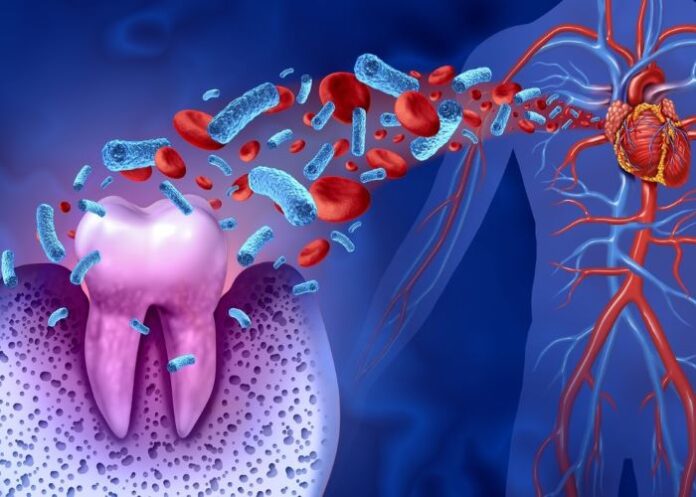The gum disease, periodontitis, can cause a number of dental problems, like bad breath, bleeding gums, and tooth loss, but now research suggests it might also be linked to more serious health issues, related to the heart.
In a sample of 76 patients with cardiac disease, scientists from the Graduate School of Biomedical and Health Sciences at Hiroshima University, Japan, found significant correlation between periodontitis and fibrosis scarring of an appendage of the heart’s left atrium that can lead to atrial fibrillation, the most common type of treated heart arrhythmia.
“Periodontitis is associated with a long-standing inflammation, and inflammation plays a key role in atrial fibrosis progression and atrial fibrillation pathogenesis. We hypothesised that periodontitis exacerbates atrial fibrosis, and this histological study of left atrial appendages aimed to clarify the relationship between clinical periodontitis status and degree of atrial fibrosis,” said the team.
The left atrial appendages were surgically removed from the patients, and the researchers analysed the tissue to establish the correlation between severity of the atrial fibrosis and severity of the gum disease.
They found that the worse the periodontitis, the worse the fibrosis, suggesting that the inflammation of gums may intensify inflammation and disease in the heart.
They said the study provides basic evidence that periodontitis can aggravate atrial fibrosis and can be a novel modifiable risk factor for atrial fibrillation. Improving other risk factors, such as weight, activity levels, tobacco and alcohol use, and periodontal care could aid in comprehensive atrial fibrillation management, they noted.
However, they cautioned that this study, published in JACC: Clinical Electrophysiology, did not establish a causal relationship, meaning that while gum disease and atrial fibrosis degrees of severity appear connected, researchers have not found that one definitively leads to the other.
While research suggests a connection between periodontitis and atrial fibrosis, further evidence is needed to establish a causal relationship and to determine if periodontal care can reduce fibrosis.
The goal of the study was to confirm that periodontitis is a modifiable risk factor for atrial fibrillation and to encourage dental specialists to play a role in comprehensive atrial fibrillation management. Periodontitis is an easily modifiable risk factor with lower costs compared with other known atrial fibrillation risk factors, thus the results of this study could have a significant impact on the health of people worldwide.
Next, the researchers said they hoped to conduct future clinical trials to clarify if periodontal intervention reduces atrial fibrillation occurrence and improves patient outcomes.
Study details
Relationship Between Periodontitis and Atrial Fibrosis in Atrial Fibrillation: Histological Evaluation of Left Atrial Appendages
Shunsuke Miyauchi, Hiromi Nishi, Kazuhisa Ouhara, Takehito Tokuyama , Yukiko Nakano et al.
Publlshed in the journal JACC: Clinical Electrophysiology in January 2023
Abstract
Background
Atrial fibrosis contributes to the onset and persistence of atrial fibrillation (AF) and AF-related stroke. Periodontitis, a common infectious and inflammatory disease, aggravates some systemic diseases. However, the association of periodontitis with AF and with atrial fibrosis has remained unclarified.
Objectives
The authors aimed to elucidate the relationship between periodontitis and atrial fibrosis by studying resected left atrial appendages (LAAs).
Methods
Seventy-six patients with AF (55 with nonparoxysmal AF, 25 with mitral valve regurgitation, 18 with LAA thrombus) who were scheduled to undergo LAA excision during cardiac surgery were prospectively enrolled. All patients underwent an oral examination, and the remaining number of teeth, bleeding on probing, periodontal probing depth, and periodontal inflamed surface area (PISA) were evaluated as parameters of periodontitis. The degree of fibrosis in each LAA was quantified by Azan–Mallory staining.
Results
Bleeding on probing (R = 0.48; P < 0.0001), periodontal probing depth of ≥4 mm (R = 0.26; P = 0.02), and PISA (R = 0.46; P < 0.0001) were positively correlated with atrial fibrosis. Among patients with >10 remaining teeth, PISA was positively and strongly correlated with atrial fibrosis (R = 0.57; P < 0.0001). After adjustments for age, AF duration, BMI, mitral valve regurgitation, and CHADS₂ (congestive heart failure, hypertension, age, diabetes, previous stroke/transient ischaemic attack) score, PISA was significantly associated with atrial fibrosis (β = 0.016; P = 0.0002).
Conclusions
The authors histologically revealed the association of periodontitis with atrial fibrosis. This indicates that periodontitis, which is modifiable, is likely a risk factor for AF.
JACC article – Histological Evaluation of Left Atrial Appendages (Open access)
See more from MedicalBrief archives:
Undetected diabetes link to heart attack risk and periodontitis
Oral hygiene linked to lower risk AF and heart failure
Evidence grows for vaping’s role in gum disease – New York University study
Dental meta-analysis: The best, worst and unproven oral hygiene tools

